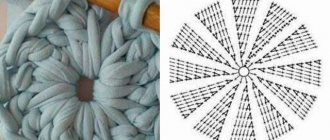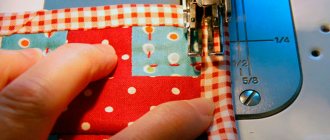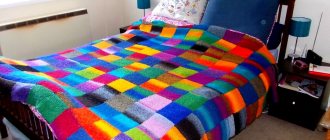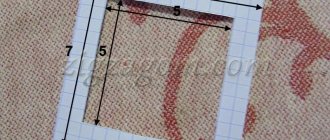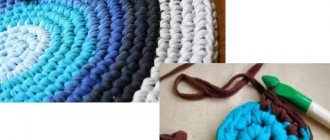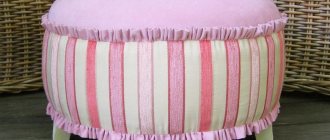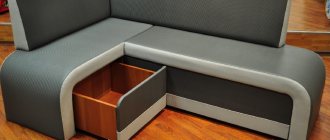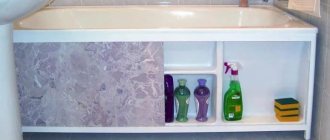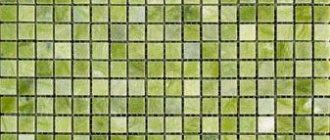Craftsmen have always used a wide variety of items for home crafts. You can make a lot of things with your own hands from a piece of already unnecessary fabric - these are beautiful curtains, bedspreads for armchairs, bright and cheerful rugs for the nursery and corridor, and even covers for flower pots. But the most popular are scraps of fabric obtained from old jeans. It is a dense and attractive fabric that can be used for a variety of purposes. For example, you can quickly and easily make a beautiful patchwork blanket from old jeans.
Pattern of bedspreads with dimensions from old jeans.
This blanket can be used for different purposes. It is perfect for a nursery if you use bright scraps of fabric for decoration. Such a blanket will be suitable for going on a picnic; it can be used as a comfortable and very warm bedding. For the job, all you need is a pair of old denim trousers, preferably in different colors, and the ability to work with a sewing machine . With a little imagination, you can transform the interior with your own hands, creating unusually attractive new things from old ones.
Patchwork styles and patterns when making bedspreads from old material
For any of the craftsmen - from beginners to professionals - they have come up with their own styles of stitching pieces into a canvas. Each type has its own characteristics and speed of production of the final product. The following popular patchwork styles are distinguished:
- Traditional style. Ideal for beginners who are just trying their hand at it. The style consists of gradually sewing together pieces of denim using a simple machine stitch. The result may be geometric shapes and ornaments that were previously conceived;
Quick square technique
- Quick square. It is also easy to perform and does not require any extra skills. For this, rectangles are taken from several fabrics and sewn along the long side, and the rest is hemmed to the resulting length.
- Watercolor style. A more complex and time-consuming option: the pieces are connected in a certain sequence of colors to get a picture or pattern. It is important to achieve a gradual change in shades of one or more colors.
- Stitching in stripes. The finished fabric will consist of strips of old jeans, sewn in a certain sequence. It can be a herringbone, zigzag or diamond pattern.
Triangle style
- Triangular style. Isosceles triangles are cut out of old material, merging along the short sides and forming motley stripes.
- Linking fragments. It does not mean stitching, but rather tying together pieces of jeans. Most often, threads made of natural and acrylic materials are used for this.
patchwork patchwork
Patchwork denim blanket
Where should newbie quilters start? The simplest product that can be sewn using the patchwork technique is a bedspread, rug or pillow. It does not require special skill or long experience, but a beginner will immediately see the results of his work and receive a finished product.
Before sewing, you need to determine the size of the bedspread in order to calculate the size of the flaps. It is most convenient to work with pieces of 12 by 12 cm. For a standard bedspread for one person, you will need 352 squares of this size.
Before cutting the material, it needs to be prepared. Trousers or other items are ripped out, washed, ironed and steamed. Do not use too high temperatures so as not to deform the fabric. After the old trousers or shirt are ripped open, square blanks are cut out of them using a pattern.
Master class on making bedspreads with your own hands for beginners:
- The denim flap is applied with the wrong side to the wrong side of the lining and folded so that the denim is on top. Then two pieces of fabric are stitched together.
- The resulting blocks are connected to each other in series, with the wrong side facing each other. This produces long strips of fabric.
- After several such strips have been formed, they are combined into a single piece and sewn together with a seam on the front side.
The second technique is called crazy. For a crazy bedspread, it doesn’t matter what size and shape the pieces of jeans are; even the smallest scraps can be used. Sewing begins from the main, central section. The basis is a polygonal flap with at least 5 corners, preferably 6–8-angled. Counterclockwise, other pieces are attached to the sides of the polygon. It is important to sew the flap to the base with the smaller side so that the cover turns out even. Blankets made from jeans patches go well with pillows made using the same technique.
Techniques for stitching flaps
It is recommended to make a blanket from denim scraps yourself only after training on light types of fabrics.
To do this, you will need to sew a blanket from square-shaped scraps of different shades, connecting them together with a machine stitch. The front part is made of shreds, and the back part consists of a lining of one large piece of fabric.
You can use unnecessary curtains, tablecloth or bed linen. Despite the wide variety, the most popular stitching methods can be identified: squares, watercolors, stripes or patchwork.
Stripes
Sewing with stripes is the simplest and allows you to quickly make a bedspread with an ornament or pattern.
It is possible to sew the fabric, forming it from scraps, according to the following instructions:
- Sew the flaps back to each other in stripes. Leave the remaining seam up to 1.5 cm wide on the front area.
- Form strips - 10, 15, 20 pcs. by parameters.
- Sew the strips together and stitch the lining at the bottom.
- On the front area at the seams, make a fringe using scissors.
To make a seam with fringe, the fabric will need to be cut along its length, moving 5 mm away from the seam. Pull out the transverse threads with a brush or your hands, and then fluff the edges of the fringe. In the case of making fabric without fringe, the blanks are sewn in strips so that the seams are hidden from the inside.
There is an additional method for stitching with stripes, which involves making a pattern. Strips of material look unusual in the form of logs, zigzags, diamonds, and fir trees. To begin with, prepare a sketch, according to which the stripes are created, and a blanket is made from them according to the intended pattern.
Patchwork
Very often, when interacting with textile materials, handmade craftsmen turn to the patchwork technique, since old jeans can be used to make a blanket based on rounded parts. This may require up to 5 pairs of trousers, a CD and a set of sewing tools.
A master class on making canvas using the patchwork technique is described below:
- When the material is prepared, apply circles to the surface of the material on the underside using a CD and a pencil.
- Draw an odd number of fragments along the contours and display a geometric figure in each.
- Along the folds, sew all the flaps together so that the stitching is even.
- Sew all marked seams, steam the circle allowances or smooth them with an iron.
- Sew the allowances with a zigzag into the inside of the rounded flaps, stitch the fabric, edge it or sew on the lining.
To create a bright product, multi-colored square-shaped scraps of any fabric or insulating material can be placed in the circles before zigzag stitching. The design is based on the accumulation of a large number of denim details, the edges of which are stitched and then decorated.
If you don’t have a lot of jeans, you can use any denim items or alternately use scraps with inserts and other material. The thinner the material, the easier it is to process and create stitches.
Watercolor
The originality of this technique is based on the fact that the fusion of denim bases is based on their combination in a set sequence, taking into account the color scheme of the material.
Initially, the plaid is created from light-colored material, placing them in the central part, and squares of dark shades are added closer to the ends. You can also do the opposite - dark middle, light ends.
The features of sewing a blanket are described in the following steps:
- Select the fragments of the flaps so that their colors smoothly intersect with each other.
- Alternating from light to dark and vice versa can be done to the center or in a spiral.
- The most important task is to create a visual effect when applying a color palette.
This work requires a lot of time and patience, since the technique is complex in selecting a color shade from a certain number of rags. The result will be a blanket that looks original with furniture upholstery, and will also improve your watercolor stitching skills.
Quick squares
The square stitching method is suitable for less experienced craftsmen. It is necessary to master the design of three-color squares from several pairs of trousers of different shades.
Also cut out 2 rectangular flaps from 2 different materials and stitch them along their entire length. The resulting seams on the wrong side are smoothed out and steamed. The third blank is made from fabric of another color range in the form of a rectangle identical to the width of the strip of 1 and 2 geometric shapes.
All prepared materials are sewn on the outer areas so that the sleeve comes out. You can cut out three-color squares from the resulting product, and also use blocks to sew the bedspread together.
Products made from scraps have always been in great demand, especially today at the peak of the popularity of handmade things. This textile will help decorate absolutely any room. Despite all the difficulties of tailoring, the finished product will turn out to be very unusual and exclusive.
What do novice needlewomen need to know?
Making a blanket from old jeans with your own hands is quite simple, because the way of joining fabric fragments is reminiscent of a regular mosaic. In order to obtain such a product, it is important to maintain consistency during work.
First you need to select materials and prepare all the necessary equipment. This must be done so that everything is at hand during the work process. Next, you have to choose the most suitable scheme - here it is important to take into account your personal preferences and the characteristics of the material.
Approximate scheme for making a blanket
Craftsmen use a variety of patterns to create quilts, and you can choose one of them or design your own. Beginners are recommended to choose the most primitive and fastest option. At the same time, the finished blanket will look no worse than more complex products. So, you can gain experience, after which any scheme will not seem too difficult.
Homemade patchwork quilt
It is important to remember that any old product from which you plan to make a blanket should be brought into a neat appearance (washed and ironed). In this case, washing should be as gentle as possible at low temperatures so as not to damage the structure of the material. For extra softness, you can dip your jeans in rinse aid.
Rules for caring for denim
Which jeans are best to use?
Even though blankets are made from old jeans, they should only be made from durable fabric. Therefore, you should choose them taking into account the following nuances:
- It is better not to use any worn fragments of jeans for work. If they are present, it is better to carefully cut them out with scissors. Any parts with holes are also not suitable for making a blanket; it is better to get rid of them immediately.
- The material should be of a single color, in which case the product will turn out to be especially attractive and even strangers will not suspect that it is made from scraps. You can combine denim material of different colors in one product, but it must have the same structure.
Old jeans should look neat
In some cases, craftswomen skillfully combine fabrics of different textures in one product. So, during the sewing process they add fragments of burlap, velvet and other materials.
Cashew nuts - benefits and harm for women and men
You don't need a pattern
Creating a denim bedspread is not much different from sewing any kind of bedspread, but the weight of the fabric introduces its own difficulties and adjustments to the process. A denim quilt should be simple to implement, so it's best to choose simple patterns, avoiding lots of small pieces that add weight and bulk to the piece.
Before you start:
- Wash denim pants or other denim items and dry them.
- There is absolutely no need to rip out every seam on the product; it will take too much time and effort. Arm yourself with scissors and cut the garment around the perimeter near the seams, leaving only the usable portion of the material. Throw away whatever is left over, or save it to create jewelry.
- Carefully inspect the material for stretch marks and damage. Pay special attention to the areas of the knees and hips, they are most susceptible to stretching.
- Cut off the back pockets and leave them for decoration.
- Gather all the resulting fabric together, and now you are ready to cut out the parts for your future bedspread.
Universal Soldier
If the wardrobe is imagined as an army headquarters in the service of a beautiful lady, then jeans will play the role of a faithful squire, who is with his general both at feast and at peace. And if we return to reality, the fabric from which comfortable and beautiful trousers are made is so practical that, even if slightly frayed, it does not lose its strength and attractiveness. So you wouldn’t dare send such a thing to a landfill. And there’s no need, because you can sew from old jeans:
- skirts;
- T-shirts;
- aprons;
- vests;
- bedspreads;
- blankets;
- bags;
- table napkins;
- chair covers;
- handbags (women's or for a laptop, tablet, phone), etc.
And if you decide to sew a blanket from old jeans with your own hands, don’t even think about throwing away the small scraps: you can use them to decorate crafts, trim clothes, and use them to decorate curtains. And to create an unusual bedspread, in addition to the trousers themselves, you will need:
- sharp scissors;
- threads, thick needle;
- sewing machine;
- lining material.
And... patience! Nothing will work without him.
We are preparing the work front
If you want not only to get a beautiful, very cozy thing, but also to experience the pleasure of working, then spend a little time preparing the material.
- Since we are talking about an item that has already been used, jeans must be washed.
- After this, we cut the trouser legs along the crotch seam, immediately cutting off the thickening of the stitching.
- We cut rectangles, squares, circles (depending on the model of the bedspread), but at the same time set aside pieces from the fabric that was on the knees and under the buttocks. These are the most worn places, so we won’t need them, otherwise the appearance of the product will be tattered.
- We prepare pieces of fabric for the lining so that the product holds its shape.
But now you can start sewing a bedspread from denim scraps with your own hands. Photos of the master classes will help you imagine what the result will be at the end.
How to make a blanket from old jeans?
The version shown in the photo shows a bedspread, each block of which consists of three strips of the same size with a seam in the middle. Proper arrangement of colors makes the blanket interesting to look at.
- Use denim in different colors to achieve dramatic differences between patchwork pieces.
- You can also use not only denim, but also add other materials to it.
- Remember - the lighter the weight of your fabric, the easier it will be for you to work with it.
Ideas for implementation: bedspreads made from old jeans and more
Combine denim with vintage fabrics:
Denim throws always look great, but this blanket from TwirlAndTango is special because it features a vintage fabric on the front. The combination is surprisingly well chosen.
Stained glass denim bedspread:
This type of throw always looks unusual, but this version from Alisha Wells of Lucy's Quilts design studio is a clear winner.
How to place bedspreads in the interior, read this article
Felt embroidered denim tablecloth
: you shouldn’t set limits for yourself and limit your imagination of working with jeans solely to bedspreads. Cherie Browning mixed denim with felt and embroidered flowers to create a whimsical tablecloth.
Denim rug with yellow rose:
Sue from Backpocket Designs used denim to decorate this rug. The girl decorated the product with a yellow rose, green leaves, and strips of fabric on the sides.
Fabric preparation
Jeans are suitable for sewing a patchwork bedspread. If there are several things of different shades and textures, this will only be a plus. Their combination will make the bedspread more interesting.
Before you begin cutting, items must be washed in warm water. After this, you should rip, or better yet, cut off all the seams and pockets on them. Areas with embroidery, rhinestones and other decorative elements can be left; they will only decorate the bedspread. Next, the fabric needs to be ironed or steamed well.
When the fabric is prepared, you should decide what parts the fabric will consist of. Several techniques are suitable for a patchwork blanket made of jeans:
- Squares . The canvas can be assembled from identical squares or squares of different sizes. For one product, you can use several templates at once - 10 cm by 10 cm, 15 by 15, 20 by 20, 25 by 25. Using shapes of different sizes is convenient because the jeans parts will produce more squares and less waste.
- Stripes . The bedspread is also easy to assemble from identical or different rectangles.
- Patchwork . More complex technology. The canvas is assembled from different shapes according to a specific pattern.
- Crazy patchwork . Suitable for making a fabric not from whole jeans, but from remaining parts (for example, if the items have already been used for some crafts). In this case, the canvas is assembled from various shapes in random order. The main thing is that the parts fit tightly together and there are no gaps between them.
Once the technique has been chosen, you can begin cutting out the parts. For convenience, you should first draw a pattern, determining the place for each fragment. Or you can cut out the parts and then lay them out on a flat surface, forming a canvas.
If any pieces extend beyond the edge line, they should simply be trimmed before or after stitching.
How to sew a beautiful blanket from jeans with your own hands: design options
Strictly speaking, everything that is sewn from scraps is patchwork. However, if a bedspread consisting of simple denim squares can be called patchwork, then it is a stretch. More complex forms are closer to this technique; the comparison can be seen in the photo.
Jeans can be combined with each other in shades and textures. It also goes well with any other fabrics, except, perhaps, satin and organza. Other fabrics only benefit from being combined with jeans.
In addition to squares, other geometric shapes are also used - mainly rectangles. They are placed differently on the base, resulting in separate geometric shapes within shapes - zigzags, squares, and so on.
Another delightful option for needlewomen is a combination of rectangles, squares, triangles, circles - and the result is something incredibly chic!
Those who think that only basic material can be used are sorely mistaken. Plaids and bedspreads made from seams, pockets and belts are no less common than those made from squares. Of course, sewing seams together with a zigzag is painstaking and tedious work, but the results are worth it. It is technically difficult to sew pockets - thick material is difficult to handle with a simple sewing machine. In addition, the pockets themselves need to be sewn up, also using a machine. But such bedspreads look very original.
Of course, it all depends on the size of the bedspread you want to get as a result. But if we talk about a simple bedspread made of squares for a one-and-a-half bed, the approximate number of fragments is about two hundred. With a final square size of 10 by 10 cm, the optimal size is considered to be from 10 to 20 cm for a square, and from 15 to 25 cm for a circle.
Of course, it is impossible to indicate the exact number of denim items that will be used to sew a bedspread - first of all, because items of different sizes naturally result in a different number of fragments.
In addition to the denim scraps, you will also need a base fabric, otherwise, in addition to a stylish bedspread, you will get an inexhaustible source of thread in the house as a bonus. Another option is a double-sided blanket, but it will cost exactly twice as much to cover the jeans.
The master class on sewing a simple denim bedspread is quite monotonous and completely uncomplicated. You perform the main actions at the very beginning. So, to work you will need:
- A certain number of jeans
- Felt pen or fabric chalk
- Scissors, tailor's pins
- Sewing machine
- Fabric base
- Dense and thick cardboard
Operating procedure. First stage. Cut a square measuring 12 by 12 cm from thick cardboard. This is the main template. Next, you need to use this template to cut out the maximum possible number of squares from the jeans. It’s rare that you can gather material for a whole blanket at one time - if you sew from old things. In fabric stores, denim is sold in rolls - buy it - I don’t want it.
However, you need to determine how many squares will go on one row of the bedspread. Considering that after stitching, the size of the square will be 10 by 10 cm, measure the width and length required for the bedspread. If you decide to decorate an old blanket, even better, you have the required dimensions; you just need to divide the numbers by 10.
When all the squares are ready, lay them out on the floor and arrange them by color or texture. With a large amount of material you can get a real work of art.
When all the details are in the order that suits you, collect them in order and number them - this way the sequence of colors will not be lost.
Second phase. It is better to sew according to the width of the blanket. Fold the blanks in pairs with their right sides facing each other, and sew a line, retreating a centimeter from the edge.
Determine the number of squares in a row yourself; after stitching one strip, you can attach it to the base or the bed itself to determine the optimal length of the strip. After all the rows in width are ready, they can be sewn along the length. It is better to fasten the threads on each row at once - otherwise, later, tying all the knots, you can go crazy.
Third stage. Fold the finished blanket of squares with the base, back to back. Secure with pins. And then sew each row along with the base. You can sew braid or bias tape around the perimeter. Another option is to fold the edges of the denim side inward along with the folded edge of the base, but this method is inconvenient and the thickness of the edges will stand out.
The blanket is ready!
Blanket made of stripes with a 3D pattern
There is another way to make a blanket from pieces of fabric, which produces an equally attractive and comfortable product. It is worth noting that for some beginners this method may seem more complicated.
The finished blanket will have such an unusual pattern
Step-by-step instruction
Step 1. It is necessary to prepare the material that will be used as a substrate. An unnecessary cotton sheet is best suited for this (the main thing is that it is intact). The cut dimensions must match the blanket. A few centimeters should be left to allow for seam allowance.
Preparing the material for the base of the blanket
Step 2. Next we need to take the denim and cut it into strips about 45-50 millimeters wide. If desired, you can make such blanks narrower or wider - it depends on what kind of blanket you plan to get in the final result.
Cutting denim strips
Step 3. Next we have to make a hem of about 1 centimeter on each side of such a strip. After that, you need to go over the hems with an iron to fix them in this position. In this case, we used three shades of fabric (we sew from darker to lighter).
We form hems on both sides of each strip
Step 4. We attach the strips of the main color to the backing using special sewing needles. The image shows seven such fragments, but if desired, you can make more of them (then the blanket will be, accordingly, wider).
We fix the strips on the substrate - it is important to check that they are positioned evenly
Step 5. Next, take a strip of a different color and pass it under the first strip at an angle (as shown in the photo).
We use a strip of the second color
Step 6. We continue to lay the same strip under the main ones. You must follow the same pattern as in the image.
We lay the strip further
Step 7. We pass another strip under the first two at the same angle (as in the image).
Passes a strip of a different color under two base strips
Do the same with the entire blanket.
As a result of the work done, this should be the basis for the formation of the subsequent drawing
Step 8. Then you should take a strip of a different color and pass it, starting from the right edge. The result should be a kind of rhombus - this allows you to connect the squares from the previous material with each other.
Pass a line of a different color at an angle
The result should be a blanket like this (after the first strip)
Step 9. The same steps must be done with another strip of this material.
Gradually, an unusual three-dimensional pattern is formed on the surface.
Step 10. After all the strips are connected, you need to fold the base and stitch it. In this way we made an unusual blanket from old jeans.
Fold the base and stitch it
Video - The idea of creating a denim rug
DIY patchwork quilt
To make a patchwork blanket from jeans you no longer need, you need to prepare a pair of trousers, maybe even ones with holes. But the pattern and layout of the patches must be taken seriously. You will get a large number of square-shaped patterns. You can first draw a drawing of what the bedspread will look like. Based on this drawing, a diagram with exact dimensions is already drawn up, and calculations are carried out. Even pockets are suitable; they can be used to decorate a bedspread in an unusual way. It turns out bright and creative; this is an ideal option for verandas and children's rooms.
To work on sewing you need to prepare:
A blanket made from old jeans will be significantly durable, so it can be safely used at various outdoor events.
- Several pairs of old and no longer needed jeans of various colors and shades. For decoration you can take green or pink.
- Cuts of fabric for the reverse side and for finishing. It can also be of different colors, have designs - all this not only does not interfere, but makes the result attractive and bright.
- The fabric for lining the bedspread is best taken from natural wool, which will give a pleasant and cozy warmth. You can use special cotton pads for bedspreads; synthetic padding is suitable. Today, the choice of such materials is varied; you just need to immediately decide why and how the bedspread will be used. If it is intended not only for decoration, but also for going on a picnic, then the best option is wool. It will be warm and cozy to sit on such a blanket.
- Strong threads and needles. The color of the thread can be different; today there are special varieties on sale specifically for working with denim. It's easy to choose the option that suits you best.
- Tailor's pins, sewing machine with a set of feet and needles. Denim fabric is very thick, so you will have to try different options first. You can purchase special feet to create beautiful curly stitches.
- Scissors, a metal ruler and chalk (or a piece of soap) for marking.
- To ensure an even cut, you can first make a pattern with the required dimensions. Using the prepared patterns, even squares will be cut.
Related article: How to choose a drill: important criteria and recommendations
From scraps into a luxurious bedspread
Making a patchwork blanket using old jeans is not that difficult, the process is as follows:
Before cutting, old jeans should be washed, dried, and thoroughly ironed.
All prepared jeans should be washed and dried, smoothed so that you can conveniently cut into even squares. While the fabric is drying, you should consider the sewing pattern, calculate the number of individual parts and their sizes. You can alternate large and small squares, diamonds and rectangles.
When the fabric has dried, you can start cutting. All jeans should be carefully ripped apart, leaving intact pieces of fabric. If there are gaps, then it's okay. It is quite possible to carefully trim the edges of such tears, and sew bright pieces of lining fabric under them, creating an unusual but attractive bedspread. Often this method is used specifically; it allows you to diversify the surface of the blanket.
To begin with, you can practice on a simpler option, then come up with something more complicated. For our denim pattern, you need to cut 64 squares, the sides of which will be equal to 23 cm. You will need 64 squares of cotton lining fabric, the dimensions of which are 20x20 cm. For the wrong side, you can use any fabric, but natural denim is best. If you don’t have enough raw materials, you can buy a piece of the required size; its cost is not so high. We must not forget about filling the bedspread; woolen fabric is prepared for this.
From old jeans you need to cut 64 squares with a side length of 23 cm.
The resulting facial denim squares can be pre-laid out on the floor surface to create a pattern of different colors, if necessary.
Using chalk or a piece of soap, apply the same marks to the front surface as in the diagram. After this, individual squares are folded to form a pie - this is the front fabric, lining, and back fabric. All squares are secured with pins.
Related article: DIY brick fence posts
Using a sewing machine, all the resulting squares must be carefully stitched diagonally in a cross pattern. After this, you get 64 blanks in the form of thick squares, which are quite enough for further work.
Next, patience is required, since sewing involves assembling all the squares into an even and neat shape. You need to start with rows, each with 8 pieces. You should retreat 1.25 cm from the edge of each square. The side of the denim square should initially be slightly larger. When all the rows are ready, you need to connect them together, getting a single patchwork blanket.
A durable and original pillow made from old jeans will go perfectly with the bedspread.
To process the edges of the blanket, strips of cotton fabric should be used; it is pre-cut. To make the edges of the connection of individual elements more attractive, the seam can be made in the form of a zigzag, using threads of a contrasting color.
In pair with such a bedspread, you can make a pillow, for which the same materials are used. Only a pattern for a pillow can be made from circles.
To do this, you will need 3 pairs of denim pants, from which 16 circles with a radius of 8 cm are cut.
This will be quite enough for a 40x40 cm pillow. Circles can be cut out using a pre-prepared pattern made of thick cardboard.
Sewing tools
Once the diagram has been found and a couple of old denim pants or jackets have been prepared, it’s time to sort out the tools. Among other things, you will need:
- Lining fabric;
- Strong threads and thick needles;
- Tailor's scissors or any other sharp scissors;
- Paws and pins, awl;
- Sewing machine (with it the process will take much less time);
- Pattern (diagram), chalk, ruler or centimeter.
“Radomir” - the meaning of the name, the origin of the name, name day, zodiac sign, mascot stones
Knitted bedspread and pillow covers
What the master advises
A few tips that are worth reading before starting work on making a denim blanket:
- Jeans should be washed, dried, ironed before steaming;
- it’s good if you can steam it with an iron;
- You don’t have to steam every seam - it’s long and tedious, just cut out the useful part of the material;
- It is better to rip the back pockets along the seam; there is no need to throw them away, they can be useful for creating a bedspread;
- it is better to make blankets from different colored jeans for contrast;
- you can add other materials;
- The total weight of the bedspread depends on the weight of the fabric;
- when making a blanket from old material, you should use special strong threads and a needle;
- old things can fall apart, so it’s better to make a blanket from large fragments.
Insulated blanket made of 9 blocks
Having mastered simpler models, you can move on to learning how to sew a blanket from old jeans, consisting of several blocks, with your own hands.
Materials:
- 7-9 pairs of jeans of different colors (blue, light blue, black, gray);
- a piece of fabric for lining;
- padding polyester;
- scissors;
- tailor's chalk;
- sheet of paper, pencil;
- pins;
- sewing machine;
- iron.
Instructions:
- Using the sample, we draw a model of the blanket, highlighting the blocks in the picture.
- We cut 20 x 20 cm squares from jeans in black and gray shades.
- We fold them in pairs with their faces inward and pin them together.
- We will need 32 such motives.
- Now we draw a diagonal on each square.
- We lay 2 lines on each square, retreating 3-4 mm from the line. For convenience, you can fold all the motifs in corners and then cut them.
- Next we make a cut along the line.
- We lay out the resulting motif and steam it.
- In the same way we make blanks from denim fabric of other colors and sizes.
- We collect, stitch, smooth.
- We group the parts into blocks.
- We sew the blocks.
- Sew on the lining.
- We put in padding polyester and sew it up. The bedspread is ready for autumn.
Round patchwork
Materials:
- CD disk;
- pencil, ruler;
- scissors;
- several pairs of jeans (4-5);
- threads, needle;
- sewing machine.
Instructions:
- On the wrong side of the cut jeans we outline a disc.
- We cut out the blanks - there should be an even number of them.
- On the inside of each circle we draw a square inscribed in it.
- We fold the blanks along the sides of the square “face” inward and sweep them away. This is a rather painstaking process, which is why many people neglect it. But with basting, the stitching lies smoother, which means the product looks neater.
- We sew according to the basting.
- Lay out the seam allowances and smooth them out. You can steam it.
- Now we make a zigzag seam along the curve of the petals.
- We bend the edges of the product and hem it. The patchwork bedspread is ready.
Based on this model, you can make a thickened blanket. To do this, a piece of bright fabric (chintz, silk) is inserted into each section before stitching the petals.
Recommendations from experienced professionals
Beginners will always find some recommendations from experienced craftswomen useful:
- It is advisable to carefully tear off the back pockets of all pairs of old jeans, because they can also be useful for decorating the finished product;
- It is not necessary to wash and iron the entire old jeans; you can first cut out fragments from them and carry out these manipulations with them;
- Don’t be afraid to combine denim of different shades in one blanket;
- you need to purchase only strong, thick needles for sewing denim;
- Jeans that are too old can fall apart during work, so it is advisable to sew them together in large fragments.
Pockets should be carefully opened
Features and rules of sewing
Features and rules for sewing bedspreads from old denim materials:
- to sew denim material, you must use thick and strong needles;
- if there are damaged elements on the material, they must be cut off;
- It is recommended to carefully open the back pockets so that they can be used to decorate the sewn model;
The blanket should be ironed at the seams
- there is no need to completely wash and iron the old denim fabric; you can initially cut off the necessary elements and carry out these actions on them;
- since very old denim can crumble during the work stage, it is recommended to sew it together in larger pieces;
- it is allowed to use a combination of fabrics of different shades, but the density of each fabric must be the same;
- The parts of the trousers that have become frayed are not suitable for use, so they should be cut off and discarded.
Old jeans are an inexhaustible source of creativity. Experienced craftsmen can make original blankets from scraps of fabric using complex sewing techniques.
By experimenting with finishing, texture and geometric shapes, you can make a beautiful model using the patchwork technique, which will add charm to the interior.
Plaid with fringes
Materials:
- 350 squares 15x15 from old jeans;
- 350 fabric squares 15x15 (can be multi-colored);
- machine;
- scissors;
- wire cutters;
- a brush with stiff bristles.
Instructions:
- Take a denim square and apply the wrong side to the wrong side of the lining.
- Let's make one more preparation.
- Fold 4 layers of fabric so that the denim side is on the outside.
- Let's make a line.
- Next, we sew the pairs into fours, fours into eights, etc.
- After all the squares are sewn, we use cutters to make notches along the seam, but so as not to damage the stitches.
- We cut off the corner joints.
- Now we “comb” the joints with a brush to create a fringe.
- If necessary, you can iron the product using the steam function to avoid distortions. The blanket is ready.
- Denim vest made from old jeans
- Bag-tablet made from old jeans
Rules of care
In order for the bedspread to last for a long time, it is recommended to properly care for the product. If it serves as a blanket for the sofa, you need to wash the product once a month, and also clean it when it gets dirty. A denim blanket will be an excellent replacement for a traditional blanket, especially if there are animals in the house. It is very easy to remove wool and any dirt from such material.
Basic care rules:
- minor dirt can be removed from the fabric with a damp sponge;
- Once a month or when soiled, wash the product in a machine with added powder: the washing mode is set according to the density of the fabric;
- You can wash the bedspread by hand: in water at room temperature and with a mild detergent;
- There is no need to soak the bedspread first;
- You can dry the bedspread in the usual way in the dryer or on the balcony.
A beautiful, original blanket made of denim patches will be a good holiday gift: it will lift your spirits, cause delight and fill the room with comfort.
